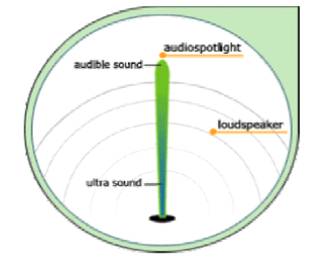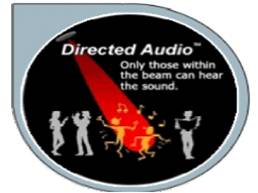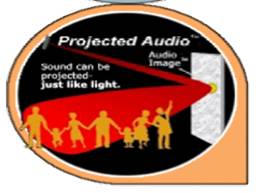Abstract
Audio spot lighting is a very recent technology that creates focused beams of sound similar to light beams coming out of a flashlight. By ‘shining’ sound to one location, specific listeners can be targeted with sound without others nearby hearing it. It uses a combination of non-linear acoustics and some fancy mathematics. But it is real and is fine to knock the socks of any conventional loud speaker.This acoustic device comprises a speaker that fires inaudible ultrasound pulses with very small wavelength which act in a manner very similar to that of a narrow column.
The ultra sound beam acts as an airborne speaker and as the beam moves through the air gradual distortion takes place in a predictable way due to the property of non-linearity of air. This gives rise to audible components that can be accurately predicted and precisely controlled. Joseph Pompei’s Holosonic Research Labs invented the Audio Spotlight that is made of a sound processor, an amplifier and the transducer. The American Technology Corporation developed the Hyper Sonic Sound-based Directed Audio Sound System. Both use ultrasound based solutions to beam sound into a focused beam. Audio spotlight can be either directed at a particular listener or to a point where it is reflected
Introduction
Audio spot lighting is a very recent technology that creates focused beams of sound similar to light beams coming out of a flashlight. By ‘shining’ sound to one location, specific listeners can be targeted with sound without others nearby hearing it, i.e. to focus sound into a coherent and highly directional beam. It uses a combination of non-linear acoustics and some fancy mathematics. But it is real and is fine to knock the socks of any conventional loud speaker.The Audio Spotlight & Hyper Sonic Sound Technology (developed by American Technology Corporation), uses ultrasonic energy to create extremely narrow beams of sound that behave like beams of light. Audio spotlighting exploits the property of non-linearity of air. When inaudible ultrasound pulses are fired into the air, it spontaneously converts the inaudible ultrasound into audible sound tones, hence proved that as with water, sound propagation in air is just as non-linear, and can be calculated mathematically.
A device known as a parametric array employs the non-linearity of the air to create audible by-products from inaudible ultrasound, resulting in an extremely directive, beamlike wide-band acoustical source. This source can be projected about an area much like a spotlight, and creates an actual specialized sound distant from the transducer. The ultrasound column acts as an airborne speaker, and as the beam moves through the air, gradual distortion takes place in a predictable way. This gives rise to audible components that can be accurately predicted and precisely controlled
Theory
What ordinary audible sound & Conventional Loud Speakers lack? What we need? About a half-dozen commonly used speaker types are in general use today. They range from piezoelectric tweeters that recreate the high end of the audio spectrum, to various kinds of mid-range speakers and woofers that produce the lower frequencies. Even the most sophisticated hi-fi speakers have a difficult time in reproducing clean bass, and generally rely on a large woofer/enclosure combination to assist in the task.Whether they be dynamic, electrostatic, or some other transducer-based design, all loudspeakers today have one thing in common: they are direct radiating-- that is, they are fundamentally a piston-like device designed to directly pump air molecules into motion to create the audible sound waves we hear. The audible portions of sound tend to spread out in all directions from the point of origin. They do not travel as narrow beams—which is why you don’t need to be right in front of a radio to hear music. In fact, the beam angle of audible sound is very wide, just about 360 degrees. This effectively means the sound that you hear will be propagated through air equally in all directions.
In order to focus sound into a narrow beam, you need to maintain a low beam angle that is dictated by wavelength. The smaller the wavelength, the less the beam angle, and hence, the more focused the sound. Unfortunately, most of the human-audible sound is a mixture of signals with varying wavelengths—between 2 cms to 17 meters (the human hearing ranges from a frequency of 20 Hz to 20,000 Hz).
Hence, except for very low wavelengths, just about the entire audible spectrum tends to spread out at 360 degrees. To create a narrow sound beam, the aperture size of the source also matters—a large loudspeaker will focus sound over a smaller area. If the source loudspeaker can be made several times bigger than the wavelength of the sound transmitted, then a finely focused beam can be created. The problem here is that this is not a very practical solution. To ensure that the shortest audible wavelengths are focused into a beam, a loudspeaker about 10 meters across is required, and to guarantee that all the audible wavelengths are focused, even bigger loudspeakers are needed.
Here comes the acoustical device “AUDIO SPOTLIGHT” invented by Holosonics Labs founder Dr. F. Joseph Pompei (while a graduate student at MIT), who is the master brain behind the development of this technology

Audio spotlight looks like a disc-shaped loudspeaker, trailing a wire, with a small laser guide-beam mounted in the middle. When one points the flat side of the disc in your direction, you hear whatever sound he's chosen to play for you — perhaps jazz from a CD. But when he turns the disc away, the sound fades almost to nothing. It's markedly different from a conventional speaker, whose orientation makes much less difference
Audio Spotlight Transducer
• 17.5”/445mm diameter, 1/2”/12.7mm thick, 4lbs/1.82kg• Wall, overhead or flush mounting
• Black cloth cover standard, other colours available
• Audio output: 100dB max
• ~1% THD typical @ 1kHz
• Usable range: 20m
• Audibility to 200m
• Optional integrated laser aimer 13”/ 330.2mm and 24”/ 609.6mm diameter also available
• Fully CE compliant
• Fully realtime sound reproduction - no processing lag
• Compatible with standard loudspeaker mounting accessories Due to continued development, specifications are subject to change
Non-Linearity Of Air
Audio spotlighting exploits the property of non-linearity of air. When inaudible ultrasound pulses are fired into the air, it spontaneously converts the inaudible ultrasound into audible sound tones, hence proved that as with water, sound propagation in air is just as non-linear, and can be calculated mathematically. A device known as a parametric array employs the non-linearity of the air to create audible by-products from inaudible ultrasound, resulting in an extremely directive, beamlike wide-band acoustical source. This source can be projected about an area much like a spotlight, and creates an actual spatialized sound distant from the transducer.The ultrasound column acts as an airborne speaker, and as the beam moves through the air, gradual distortion takes place in a predictable way. This gives rise to audible components that can be accurately predicted and precisely controlled. However, the problem with firing off ultrasound pulses, and having them interfere to produce audible tones is that the audible components created are nowhere similar to the complex signals in speech and music. Human speech, as well as music, contains multiple varying frequency signals, which interfere to produce sound and distortion. To generate such sound out of pure ultrasound tones is not easy.
This is when teams of researchers from Ricoh and other Japanese companies got together to come up with the idea of using pure ultrasound signals as a carrier wave, and superimposing audible speech and music signals on it to create a hybrid wave. If the range of human hearing is expressed as a percentage of shift from the lowest audible frequency to the highest, it spans a range of 100,000%. No single loudspeaker element can operate efficiently or uniformly over this range of frequencies. In order to deal with this speaker manufacturers carve the audio spectrum into smaller sections. This requires multiple transducers and crossovers to create a 'higher fidelity' system with current technology.


Conclusion and Future Scope
“Being the most radical technological development in acoustics since the coil loudspeaker was invented in 1925... The audio spotlight will force people to rethink their relationship with sound…”-NewyorkTimes
So we can conclude- Audio Spotlighting really “put sound where you want it” and will be “A REAL BOON TO THE FUTURE.”
References
• www.thinkdigit.com• www.holosonics.com
• www.spie.org
• www.howstuffworks.com
• http://www.seminarsonly.com/electronics/audio-spotlighting-seminar-report-ppt-pdf.php
1 comment:
column speaker supplier
Post a Comment